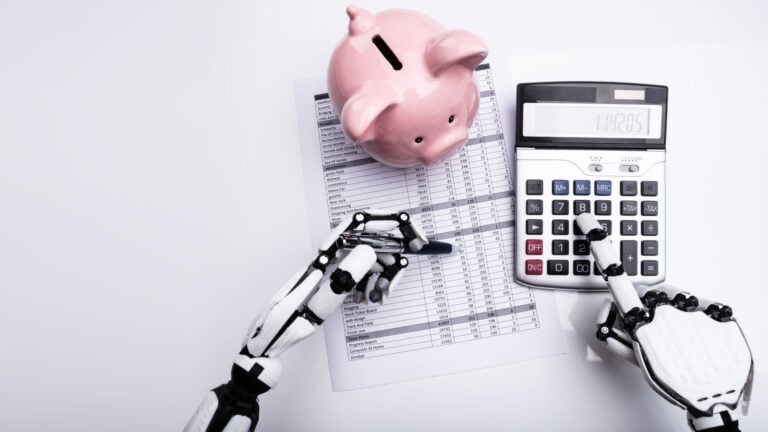
Source: Shutterstock
Editorial Note: InvestorPlace Beacon independently determines what we cover and recommend. We earn a commission from affiliate partners on many offers and links. However, these commissions do not affect our editors' opinions or evaluations. Click here to read our full advertiser disclosure.
More and more banks are using AI to interact with customers, predict market trends, identify money laundering and more. Learn how AI presents new opportunities and potential threats to everyday banking.
How AI Will Change Banking
In 2023, there was an explosion of AI usage thanks to popular systems such as ChatGPT and DALL-E. In 2024 and onward, banks are expected to continue finding new ways to bring the technology on board.
Artificial intelligence (AI) can help banks automate lengthy processes, provide quick fraud monitoring, offer more accurate financial predictions and more. The banking industry is one of the biggest users of AI learning, according to a 2023 study by S&P Global. Both nationwide and community banks have started to use AI and machine learning (ML) in their systems.
| Pro Tip |
| Many banks use the phrases AI and ML. ML is a smaller subset of AI. Think of AI as the general ability for computers to emulate human thoughts. ML refers to the technologies and algorithms that enable systems to identify patterns and make decisions. |
The same S&P study predicts generative AI solutions will accelerate over the next two to five years with incremental benefits.
Below are several other ways you can expect AI to change the banking landscape.
3 Key Ways AI Will Affect Banking
- Transaction monitoring and detection, such as:
- Automating fraud detection
- Identifying money laundering and terrorist financing activities
- Customer and organization profiling, such as:
- Analyzing vast datasets from vendors, customers, market trends and industry regulatory updates
- Analyzing policyholder information and claims histories
- Automation and efficiency improvement, such as:
- Providing answers to compliance-related questions
- Managing regulatory requirements
Source: Moody’s Analytics
Is AI in Banking New?
Banks have been using AI for years now. Bank of America, for instance, introduced a digital assistant in 2016 called Erica, which uses AI to help customers make banking decisions. In 2018, Citigroup partnered with AI-powered startup Feedzai to enhance fraud detection.
But experts say there’s more to come.
AI Examples in Banking
| Bank | AI Usage |
| Bank of America | The bank has a virtual AI-driven assistant, Erica. Erica detects fraud and helps with common inquiries. Bank of America has also started investing in AI, machine learning and business intelligence to offer personalized, client-specific advice and resources. |
| Discover Bank | The bank implemented an AI-based underwriting platform, which it says can reduce default rates significantly without added portfolio risk. |
| Nationwide | The bank has AI models for sales support and complex product underwriting. |
Banks and credit unions alike are looking for more opportunities to incorporate AI and ML amid a wide influx of AI usage across industries beyond finance. In fact, AI is expected to contribute up to $15.7 trillion to the global economy by 2030, according to Bank of America.
While these changes will likely come with benefits, they should also be viewed with skepticism.
AI Opportunities and Threats
When AI is used to augment human intelligence, instead of entirely replacing it, it can be a helpful resource for banks. Lengthy processes that would usually keep bankers in an office for 90 hours a week could be simplified with a few AI tools, according to the Harvard Business Review.
Key AI Usage Opportunities for Banking
- Faster and more accurate decision making
- Simplified operations, reduced costs and improved efficiency
- Enhanced risk management practices
- Improved customer financial wellbeing, literacy and experience
Source: S&P Global
However, there are also potential threats that come with AI in banking, such as job loss. Bank of America estimates that AI will displace 2 billion jobs by 2030.
There’s also concern for customers’ data. Moody’s Analytics conducted a survey asking how customers feel about AI usage regarding risk and compliance.
Below are the top four concerns from the respondents:
- 55% are concerned about data privacy and confidentiality issues
- 53% are concerned about misuse or misunderstanding of AI
- 55% are concerned about the lack of transparency in decision making
- 52% are concerned about an overreliance on AI
Source: Moody’s Analytics
To ease these concerns, banks will need to confer with compliance officers to keep AI risks mitigated.
How Compliance Professionals Feel About AI
Despite the potential risks, most compliance professionals seem to have an overall optimistic outlook for AI usage in financial and nonfinancial institutions. The Moody’s Analytics survey found that 82% agreed or strongly agreed that AI will deliver significant advantages within the risk and compliance function.
But that doesn’t mean banks should incorporate all AI and ML processes without a second thought. Standard framework and legislation should be drafted to ensure AI in banking has long standing success with proper regulations, according to Moody’s.
5 Solutions for Successful AI Integration in Banking
- Creation of standardized regulatory framework, so countries and states are on the same page
- Transparency, accountability and human oversight
- Ethical deployment and data privacy
- Education around AI for regulators and the public
- Flexible and adaptable legislation
Source: Moody’s Analytics
Sources:
Harvard Business Review. (2023, December 18). How Banks Can Stay Resilient as AI Becomes More Disruptive. Retrieved from https://hbr.org/2023/12/how-banks-can-stay-resilient-as-ai-becomes-more-disruptive
S&P Global. (2023, October 31). AI in Banking: AI Will Be An Incremental Game Changer. Retrieved from https://www.spglobal.com/en/research-insights/featured/special-editorial/ai-in-banking-ai-will-be-an-incremental-game-changer
Moody’s Analytics. (n.d.). Navigating The AI Landscape. Retrieved from https://www.moodys.com/web/en/us/site-assets/ma-kyc-navigating-the-ai-landscape-report.pdf
Bank of America. (n.d.). Artificial Intelligence…Is Intelligent! Retrieved from https://business.bofa.com/en-us/content/ai-trends-impact-report.html
Columbia Engineering. (n.d.). Artificial Intelligence (AI) vs. Machine Learning. Retrieved from https://ai.engineering.columbia.edu/ai-vs-machine-learning/



